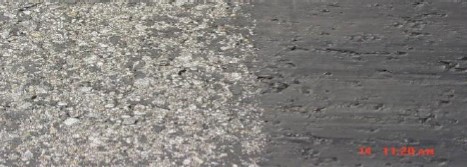Rubber Removing


Our task involves the removal of rubber deposits that accumulate on runways as a result of the landing and take-off of turbojet aircraft. These rubber deposits pose a significant concern as they can lead to a reduction in the friction coefficient of the pavement surface. This reduction in friction coefficient has the potential to create problems, especially when the runway is wet.
Rubber contamination on the runway surface is a common issue faced by airports. During the landing and take-off of turbojet aircraft, the tires generate heat and friction, causing small particles of rubber to detach and adhere to the pavement. Over time, these rubber deposits can accumulate and form a layer on the runway surface.
The presence of rubber deposits on the runway is problematic due to its impact on the friction coefficient. The friction coefficient is a measure of the resistance between two surfaces in contact. It plays a crucial role in the safe operation of aircraft during landing, take-off, and taxiing. Adequate friction is required to ensure proper braking action, effective tire grip, and directional control.
When the runway is wet, the reduction in the friction coefficient due to rubber contamination becomes even more critical. Water on the runway surface acts as a lubricant, further reducing the friction between the tires and the pavement. This can result in compromised braking efficiency, reduced tire grip, and increased stopping distances for aircraft.
To address this issue, our team is dedicated to the removal of rubber deposits from runways. We employ specialized equipment and techniques designed specifically for this purpose. High-pressure water blasting, commonly known as hydro blasting or hydro jetting, is one of the methods we utilize. It involves the use of highly pressurized water streams to effectively dislodge and remove rubber deposits from the pavement surface.
By employing rubber removing, we can restore the desired friction coefficient on the runway. This process removes the accumulated rubber, allowing the pavement surface to regain its texture and grip. The result is a safer runway that provides better braking capability and enhanced directional control for aircraft operations.
Regular maintenance and removal of rubber deposits are crucial to ensure optimal runway conditions. Our services are often scheduled as part of routine runway maintenance programs to prevent the buildup of rubber contaminants and maintain adequate friction levels.
In conclusion, the removal of rubber deposits from runways is essential to address the potential problems caused by reduced friction coefficients. The accumulation of rubber deposits on the runway surface, particularly when the pavement is wet, can compromise the braking capability and tire grip of aircraft. By employing specialized techniques such as hydro blasting, we can effectively remove rubber deposits and restore the desired friction coefficient, ensuring safer and more efficient runway operations.
Interested in this Product? Contact Us Now
